- David & Jessica arrive in Europe - Los Angeles, California to Madrid, Spain to Vienna, Austria
David and Jessica left California on Monday, May 23rd from LAX and fly to Madrid. The flight is about a half hour late in arriving and after passing through immigration and customs, we have less than 30 minutes to catch our connection to Vienna. Fortunately we have already printed out the boarding passes and after going through security a second time (where we confiscate Jessica's nail file), we make it to the gate with about 10 minutes to spare. The flight to Vienna is very cramped, with David's knees pressing the seat in front no matter how he sat. Approaching Vienna, the plane performs a sudden drop, and Jessica's stomach went with it. She tossed her cookies (very neatly one might add) into the provided bag and soon felt much better. We arrive in Vienna in good shape and collect our luggage.

David & Jessica at LAX
- Vienna, Austria
We catch the airport bus for the Westbahnhof train station, which is just up the street from our hotel. Upon arrival we decide to walk to the hotel, but strike out in the wrong direction. After asking for help from a local we find our hotel and check in. We have been in the air for 16 hours and are hungry. We dined at a nearby small café on spargel (a rare treat made with white asparagus) and the local beer. Except for the delay to get our check, we were provided with a wonderful meal. We hit the hay knowing that our Danube Valley Tour starts at 9:30a in the morning.
The next morning we are up and breakfasting in the hotel dining room and at 9:10a we call the tour company to find out what time they will pick us up. Turns out we should have made this call a few days earlier, because they needed to pick us up at 8:30a, and we have missed the tour for that day. We decide to visit Vienna on foot and strike out for the Schönbrunn Palace (the emperor's summer cabin). This place is pretty amazing. We took a special guided tour with a man who was raised in Vienna with one Austrain parent, and one British parent. He speaks English flawlessly and provides all sorts of information about the palace, including it's occupants (the Habsburg family), all the marriages that took place between various royal houses on the continent, the history of the building itself, and all about the contents that have been imported from all over the world.
After leaving we decide to take the subway to our next destination. We try several times to buy a ticket (even a group of local kids offered to show us how to buy tickets without success), but the system rejects our card repeatedly. Finally we jump on the train anyway and ride it the rest of the day for free. Our next stop is St Stephen's Cathedral, a truly amazing structure. The square surrounding the cathedral is filled with street performers and others vying for tourist dollars (you couldn't walk ten feet without someone trying to sell you "concert tickets" for that evening in one of their prestigious halls).
From there we visited the ancient Ferris Wheel (built just three years after the famous original Ferris Wheel in Chicago, constructed for the 1893 World's Fair). We go from there to see the Danube, then to Beethoven's house, the Burgtheater and the Rathaus-Platz (Vienna City Hall Square). This is where we found our first public drinking fountain (and apparently the Austrians think it's a pretty big deal as well). We finally staggered back to our hotel, enjoyed some wiener schnitzel and went to bed.
The next morning we were up early, checked out and walked to the Westbanhoph station to catch our train to Salzburg. Everything went without a hitch.
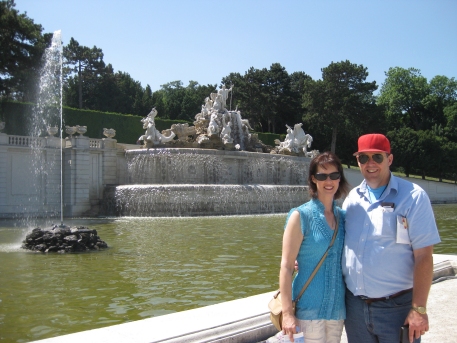
David & Jessica at Schönbrunn Palace Gardens

Jessica inside St Stephen's Cathedral

David & Jessica at the Danube
- Salzburg, Austria
Arrived in Salzburg right on time (they really have the railroad system down in Europe). The only inconvenience is the Salzburg station is undergoing a complete rebuild, and because of the construction there's no station proper, just platforms and scaffolding. We found our way to the taxi stand and were taken to our hotel where we quickly checked in and then left to find "Bob's Tours" where we were scheduled to take a "Sound of Music" tour. This tour visits all the sites in Salzburg that were used in the making of the classic film, The Sound of Music. We visited the mansion used as the exterior of the Trapp family house, the gazebo used for the famous "Going on Seventeen" song and dance, saw the mountains used in the opening number, the graveyard used at the end of the film and even visited the church used in the wedding scene between Maria and the Captain. Along the way we stopped so that members of our tour could ride an Alpine toboggan slide. As we rode through the hills, our guide played the CD from the movie so we could all sing along (which Jessica did enthusiastically!)
Upon our return we were dropped of at the Mirabell Palace Gardens, where we strolled around and saw the rose garden and the 13 statues of dwarfs, which were modeled after actual members of Archbishop Wolf Dietrich Raitenau's staff. From there we walked to a restaurant near our hotel and had native dishes of bratwurst and veal.
The next day we checked out, but left our bags at the hotel, borrowed the last umbrella from lost and found, then decided to tour the old part of the city (which has been turned into a vast tourist attraction), even though there was a light rain through most of the day (which made us very glad we had done the Sound of Music tour the day before). We visited the Salzburg Museum, several of Mozart's houses (and his statue), the Hohensalzburg Castle at the top of the funicular, about a half dozen churches, etc, etc.
Late in the afternoon, cold and wet, we found a quaint tea and coffee shop that served cakes and pastries. We had perhaps the best cup of cocoa and delicious pieces of cake you can imagine. We caught a bus back towards our hotel (after initially going the wrong direction) and got dinner in a small Italian place, and it was here we learned that you must ask for the dinner check it you want them to deliver it. They consider it rude to drop the check if you haven't asked (knowledge of this could have saved us some time in Vienna).
We walked the short distance to our hotel (by now it's about 9:30p) and then caught another bus with our luggage to the train station. They have built some small glass enclosed rooms on the train platforms that you can wait in, which was good because our train was not scheduled to leave until 1:30a, and it was getting very cold. The train did arrive at the platform around 12:10a and we were able to board early and get settled into our sleeping compartment. We woke the next morning around 7:30a when the steward brought our breakfast. An hour later we pulled into the Santa Lucia train station in Venice.
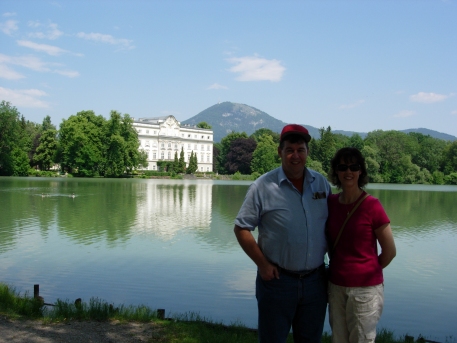
David & Jessica in front of the mansion used for the Trapp Family manor
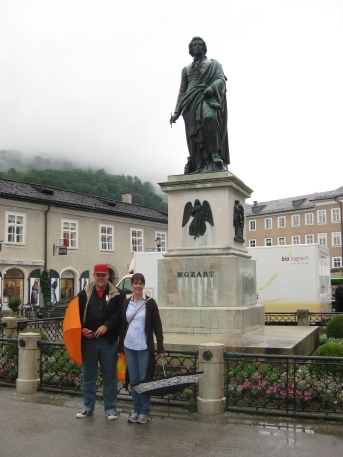
David & Jessica in front of the statue of Mozart
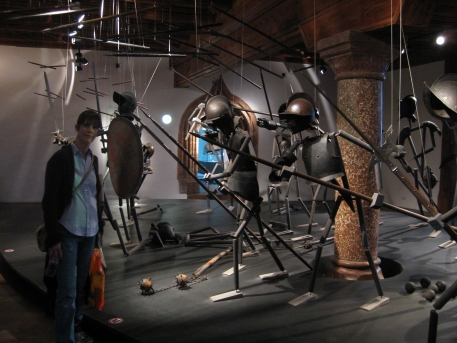
Jessica in the Hohensalzburg Castle Museum and the Armor display
- Meg arrives in Europe - Tucson, Arizona to Dallas, Texas to Madrid, Spain to Venice, Italy
Meg flew separately from Reid and Mark since Reid and Mark were going to continue on to Israel after Barcelona. Meg's first flight to Dallas was cancelled because of hail damage in Dallas. It was quickly rebooked a bit earlier. She had a longer lay over in Dallas and spent that time in a Mexican restaurant eating chips and dip along with strawberry margaritas. A good time was had by Meg. Arriving in Madrid a bit late because of a late departure from Dallas caused a bit of a rush. The new gate was as far away as possible and yet still be inside the Madrid Airport. The flight to Venice was uneventful. She took the bus to Venice from the airport for 5 euro and the People Mover to near the ship for 1 euro. Boarding was very easy.
- Reid and Mark arrive in Europe - Tucson, Arizona to Atlanta, Georgia to Paris, France to Venice, Italy
Reid and Mark flew through Paris where Reid's ATM card was eaten by the ATM. He put it in and entered his PIN once and it ate it. He called his bank and they gave him the run around. Luckily Mark and Reid had additional ATM cards. Arriving in Europe, only Mark's iPhone worked. Meg had spoken with AT&T before leaving and asked that all phones work in Europe. Meg later used Jessica's phone to call AT&T and get them all working. There was no reason that only Mark's worked and no excuse for that.
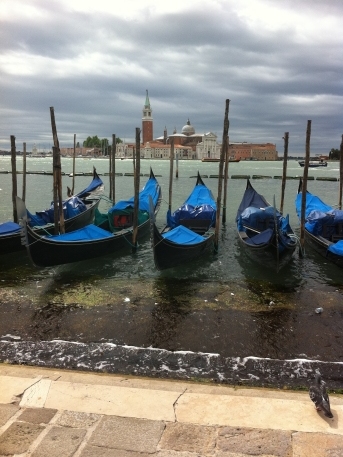
Gondolas in Venice
- Venice, Italy
As we walked down the platform in the Santa Lucia train station, we were concerned about all our luggage. We were supposed to meet our friends Stewart and Valerie Leicester at St Mark's Square in about an hour, and we couldn't lug all these bags with us. Fortunately, there was a guy with a sign that said "Ruby Princess Luggage", and we found out that for €5.00 per bag they would deliver the luggage to our cabin on board our cruise ship. David had printed out the luggage tags before we left, so it was just a matter of attaching them to the handles and paying the 20 euros. Free from our bags, we bought tickets for the vaporetto and took the water bus down the Grand Canal to visit St Mark's Basilica, the Doge's Palace and the famous Clock Tower tour. Arriving at the square about 9:30a, we called the Leicester's to find out where they were and found out they were on their way, but had gotten turned around and missed the water taxi. They elected to walk and showed up just a few minutes later.
The line into St Mark's Basilica moved quickly and we toured it for about an hour. They refused to allow Stewart entry with his backpack and gave him directions to an alley several blocks away where he could check it. Fortunately he didn't get lost and rejoined the party shortly. If this hadn't been the tenth massive church we had seen in the past few days it would have been just amazing. As it was, we were slightly jaded. The special room where they kept all the saints relics (read "body parts") was especially eerie. We climbed an extremely steep, narrow flight of steps to get to the balcony and outdoor access. At the top of the stairs was a cashier requiring payment to enter... the gift shop! And through the gift shop access to the rest of the second floor. The views from the outside balcony were tremendous.
Next stop was the Doge's Palace "Secret Tour", where a guide takes you on an extended tour of the building, especially its prisons, and explains the whole history of Venice from the view point of the Doges'. This was very interesting and we learned that Casanova was a prisoner there, the only one to successfully stage a jail break. We were shown the special rooms where the secret trials were held, as well as the prison cells where political prisoners and traitors were kept. It made you want to be on friendly terms with the powers-that-be.
After the Doge's Palace, we wanted to get a bite to eat. Our tour book recommended a street just on the other side of the square that had a number of sandwich shops. The specific place we were looking for was closed, but we found a nice place across from it. This is where we got our first taste of just how expensive things could be in Venice. David bought a Coke (just a regular Coke) and, because we elected to sit down to have our meal, the cost was €5.00. This is like $7.50 for a Coke. Later, in Barcelona, David was able to get two liters of Coke for €1.60 (about $2.40). Despite the sticker shock - and the expense of sitting down - the meal was delicious and it was nice to have a seat. On the way back to the square, we tried to get a picture of the Bridge of Sighs, but because of the crowds and renovations taking place, it was almost completely obscured.
Our last tour was of the famous clock tower that was constructed at the end of the 15th century. This was quite a piece of craftsmanship, and is still working today (but there is no longer a time keeper living in the tower, that position was eliminated in 1998 and now the clock is wound by machines). This was the first clock in the world to go digital, when Roman and Arabic numerals were added in the 1850s. We climbed the spiral staircase and visited all floors including the roof. Along the way we saw the four figures that are used on Epiphany and Ascension Day, the three Wise Men and an angel. These figures were used every day until the clock went digital whereupon they were retired and only brought out twice a year.
It was now getting late in the day and we decided to leave St Mark's Square and head to our cruise ship, the Ruby Princess, stopping to pick up Stewart and Valerie's luggage at the hotel they had spent the night in. We took several wrong turns (there is no easier city to get lost in than Venice, at one point there were four distinct groups of tourists on a single bridge perusing their maps, to no avail), but finally located their hotel and with their luggage in tow headed to the ship. We got to the people mover and for one euro we were transported to the cruise terminal. We checked their luggage and passed through embarkation in record time. Safely aboard the ship, everyone agreed it would be a good time to get dinner and that the gondola ride would have to wait for our next visit. About this time we hooked up with Meg, Reid and Mark (who had flown in from Tucson). We left Venice the following morning in a beautiful "sail away" and now had two days at sea as we sailed toward our first port of call...
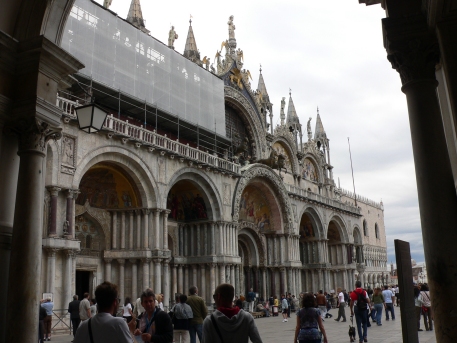
St Mark's Basilica and Doge's Palace in background
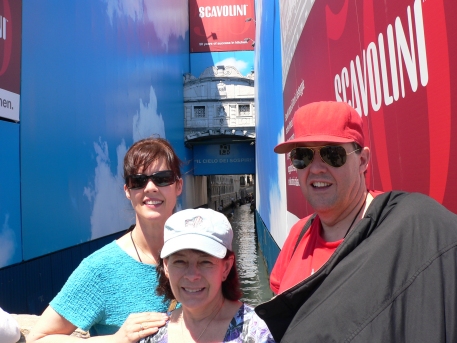
Jessica, Valerie and David at the hard-to-see Bridge of Sighs
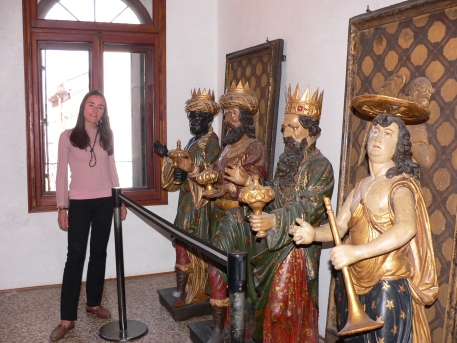
Inside the Clock Tower with our tour guide
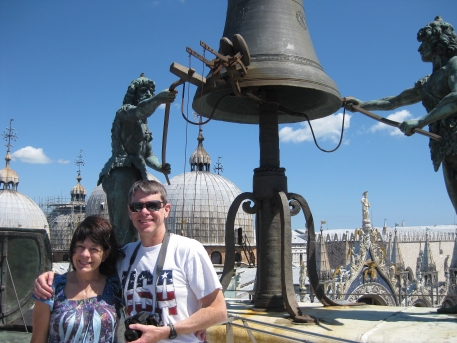
Valerie & Stewart on top of the Clock Tower
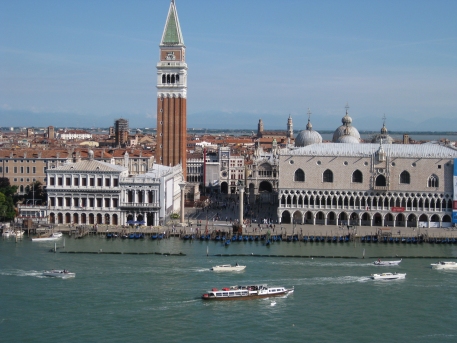
St Mark's Square during our sail away
- Athens, Greece
We made port in Piraeus (the port city for Athens) and were off the ship after breakfast. Our guide and driver arrived at 10:00a and drove us first to the changing of the guard of their Tomb of the Unknown Soldier outside of their Parliament building. The soldiers there wear a very traditional dress with strange shoes and march in an exaggerated fashion.
From there we went to the Temple of Olympian Zeus, a very old site. You can see the Acropolis and the Parthenon from there.
We then jumped back in the van and rode most of the way to the Acropolis, but had to get out and climb the rest of the way when the traffic backed up. We visited the Areopagus (Rock of Ares) where the Apostle Paul preached to the Athenians, and from there you had a panoramic view of all of Athens and a good look at the Greek Agora. We then climbed up further into the Acropolis, first passing by the Odeon of Herodes Atticus. Then we climbed still further and saw the temples up close, including the Parthenon, the Old Temple of Athena, and the Erechtheum.
Now our walking really started (but most of it was down hill). We left the Acropolis and walked along a perimeter road that purported to have some of the most expensive houses in all of Athens. Along this way we visited the Theater of Dionysis (Jessica insisted on stopping at the this theater, which she had studied about in college), passed the Roman Agora (which has the Tower of the Winds), stopped at the Library of Hadrian, and finally got to the Greek Agora with the Temple of Hephaestus and the restored Stoa of Attalos.
From there we found ourselves once again in the small back streets of Athens until we came to a restaurant recommended by our guide. All of the women in the party were invited into the kitchen to see the fare and have explained what each dish was. We had one of our best meals off the ship at this lovely outdoor café. From there our driver picked us back up and took us back to the ship. We saw some of the people protesting the government's austerity plans and a small tent-city, but nobody was actually rioting. All in all an exhausting, but enlightening and fun day.
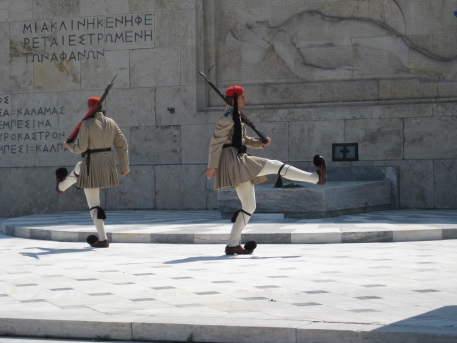
The changing of the guard in front of the Tomb of the Unknown Soldier
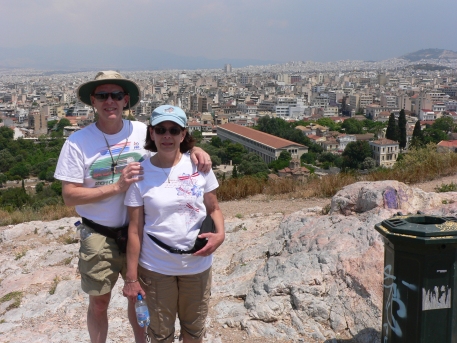
Stewart & Valerie at the Areopagus (Rock of Ares) with the
Stoa of Attalos and the Greek Agora in the background.
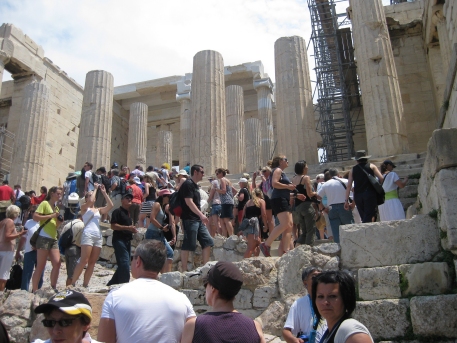
Walking up the Acroplolis to see the Parthenon.
The place was lousy with tourists
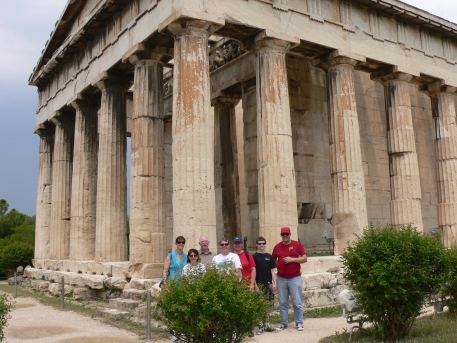
Jessica, Valerie, Reid, Stewart, Meg, Mark and David
at the Temple of Hephaestus in the Greek Agora
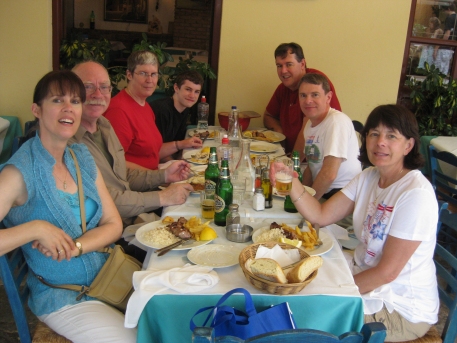
Jessica, Reid, Meg, Mark, David, Stewart and Valerie
enjoy a traditional Greek lunch, a wonderful meal!
- Ephesus, Turkey
The ship docked in Kusadasi (the port city for Ephesus) and everyone but Stewart and Valerie had signed up for the Ephesus tour (which included the purported last living place of Mary, the mother of Jesus, and the Tomb of the Apostle John). Valerie and Stewart decided to hike the port and investigate the many jewelry stores; in fact Stewart decided he couldn't pass up the chance to buy Valerie a birthday-present bracelet. Even though the Zechiel's and Silvern's were all on the same tour, we found ourselves on different busses and visited the sites in a different order. David & Jessica's bus went first to the location where Mary is supposed to have lived her final years. There's a very small house that seems to have been reconstructed over ruins discovered in the 19th century. It is very quaint. Upon leaving the house you come upon a wall where people have written down prayers and placed them into a lattice. There are also spigots in the wall that dispense "healing water" (but it seemed very much like normal water to us).
From there we went to the ancient city of Ephesus, where the Apostle Paul preached to the Ephesians. This place is really impressive. You start at one end where there's a modest size theather (seats 5000) and some scattered ruins. Just as you think, "Is that all?", you find yourself proceeding down the ancient main boulevard that has all manner of shops, living quarters, shrines (even the communal lavatory). From there you arrive at the Library of Celsus, a truly impressive building. Our guide, Fisune, was informative all along the way and explained the purpose of each building and how it was used. Leaving the library you come upon the REAL theater, this one seats 25,000 and is still used today (we were told the last performer was Sting). Jessica stood on the stage while David went to the upper reaches and, because of the acoustics, we were able to hear each other just fine.
When visiting ancient sites like Ephesus (and most of Athens, and later Delos and Rome) you start to see where the local archeologists have become overwhelmed with everything that they have found and dug up. One sees large fields with neatly placed ruins, row after row after row, all carefully labeled, waiting for some future generation of archeologists to come along and sort through everything. This may be the reason that they allow visitors to go right up and touch or even sit on these ruins that are, in some instances, over 4000 years old. They have so many ruins, that they start to lose any special quality they may have because of uniqeness.
As we were leaving the Ephesus site, there were a number of store fronts and souviener stands. Jessica wanted some simple gold hoop earrings, and we stopped at one of the jewelry shops. We saw a pair that looked very much like what we wanted, but the clasp was the wrong kind and made it difficult to put into her ear. The salesman had told us that the earrings normally cost 172 euros, but he would let us have them for 160. Because they weren't what we wanted, we said "No" and immediately the price started to drop. It went to 145, then 130, then 120. With each price drop we were assured this was because we were his first customers of the day, and he really wanted to make the sale. After saying "no" again, the price hit 100, then 85 then 75. It turns out this is the actual sale price, because when we said "no" once again, he said to David, "You... are an unpleasant American", and we were on our way.
Then the bus took us to the Tomb of John the Apostle at the site of the Basilica of St John, built in the 6th century, just below the Grand Fortress of Selcuk on Ayasoluk Hill.
Back on the bus once more we were delivered to the port but had to walk a regular gauntlet of security and duty-free shops to find the ship. Once we were back on board the ship we heard the names of people who had failed to return being broadcast on the PA. The story is that eight people had to catch an overnight bus to Istanbul to meet up with the ship the next day. Thankfully, we were on board.

David & Jessica at Mary's last residence
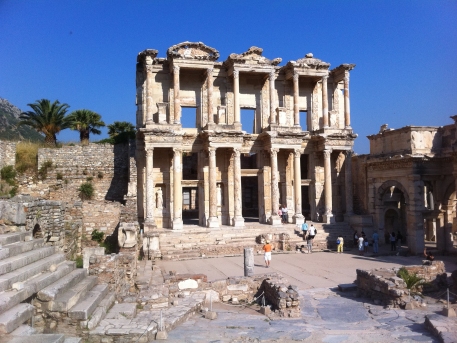
The Library of Celsus in Ephesus, very impressive!
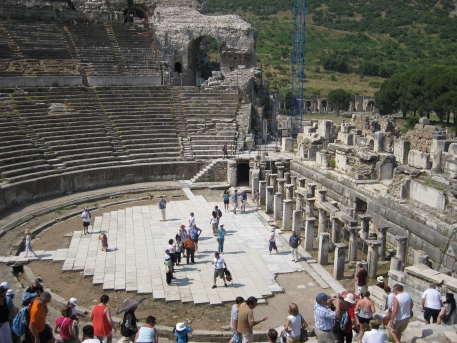
Jessica on the stage of the large theater in Ephesus

Jessica stands next to an ancient baptismal font
in what's left of the Basilica of St John
- Istanbul, Turkey
Our guide and driver were waiting for us the moment we got off the ship and drove all seven of us to the center of historic Istanbul. We started at the top of the Hippodrome of Constantinople, a sporting and social center of the capital. There we saw the Obelisk of Thutmose III, the Serpent Column, the Walled Obelisk and passed the German Fountain.
From there we visited Sultan Ahmed Mosque (also known as the Blue Mosque, because of the copious use of blue tiles in the interior), this place was most impressive. We stood in a long line and had to remove our shoes (we were given plastic bags to hold the shoes). Jessica and Val opted to use the restroom there, which may have been a mistake. First, you have to pay, and second, you are presented with a hole in the ground to do your business. Fortunately, there was a toilet next to it with a door, and everyone chose to stand in that line. Still on foot we next visited St Sophia Basilica. This place was a Christian Orthodox Church from 562 to 1453, was forcibly converted to a mosque until 1931 and is currently a museum.
Next was a visit to the underground Basilica Cistern. This place really impressed. Built in the 6th century, it provided water storage and filtration for the local fortress in case of a siege. It held 2.8 million cubic feet of water when full. There are 336 marble columns supporting the ceiling. Stone steps allow you to descend into the cistern where walkways above the water have been constructed. Orange lighting on the columns makes for an impressive display. Two of the columns have the head of Medusa at their base. There are lots of theories why they are there, but no one knows for certain.
We started walking again toward the Grand Bazaar. Our guide asked if we were interested in a Turkish Carpet Demonstration. We said "sure", but didn't really know what we were getting into. Wandering down increasingly smaller streets, we found ourselves in a very nice carpet shop. Their hospitality was very, very good, as they asked if anyone was hungry or thirsty, and a moment later sandwiches and tea appeared. However, instead of a "demonstration" what we really got was an education on Turkish carpets, how they are constructed, what they are made of, and especially how much they cost. It was a sales pitch for carpets. Had we needed one, we would have not hesitated, but nobody in our party was buying, and after 40 minutes or so they let us go.
We continued to the Grand Bazaar and shopped in the largest covered market in Turkey, and probably the world. It was fun trying to figure out if you should offer dollars, euros or lira (the local currency) in order to get the best deal. Our driver picked us up and lastly we visited the Egyptian Spice Market which was also fascinating. We tasted some saffron and pistachio nuts, then bought some Turkish Delight (a local confection), as well as other trinkets for friends back home. Finally our driver picked us up the last time and delivered us back to our ship in plenty of time.

Mark, Meg, Valerie, Reid, Stewart, Jessica and David
at the Serpent Column in the Istanbul Hippodrome

Jessica in front of the Sultan Ahmed Mosque in Istanbul

Interior of St Sophia Basilica
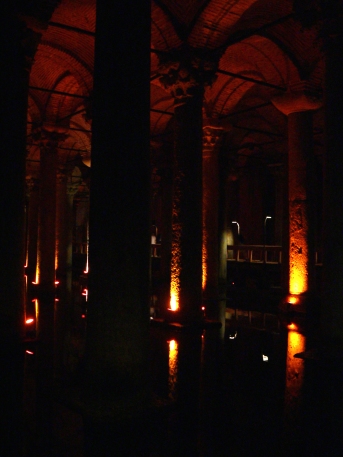
The huge underground Basilica Cistern between
the Blue Mosque and Hagia Sophia
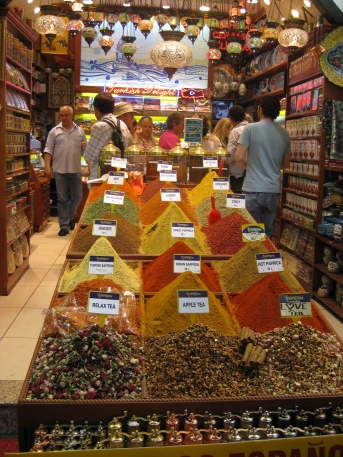
One of the shops in the Egyptian Spice Market
- Mykonos, Greece
This is a small island in the Aegean Sea that belongs to Greece. It reminds one very much of Santa Catalina Island off of the Southern California coast, and the city of Avalon. Avalon subsists almost 100% on tourist dollars and has a series of shore boats that they send out to meet every cruise ship that stops by. At Mykonos we had to tender in, the Ruby Princess was way too large for any dock they had on hand. At this point our party split into two. David, Stewart, Reid, Mark and Meg elected to take a tour of the nearby island, Delos, which is famous for its archeological site. Jessica and Val elected to hire a car and were simply driven to a beach where they lay out below cabanas and drank (Jessica had a Long Island Tea, Valerie a Diet Pepsi). On the way back their driver took them by the old windmills and by "Little Venice". Then they got lost in the twisty maze of alleys that make up the coastal town, but did manage to find their way out. They both noted that all the building are plastered and painted white, which makes the town look clean and attractive.
Boarding a ship that held a couple of hundred, we made our way to Delos (about 30 minutes) where we were taken on a guided tour of the excavations that continue to take place. This island has been inhabited in some manner since the 3rd millennium BC (although today it only has 14 permanent residents, all archeologists). It is known as the birthplace of the twin gods Apollo and Artemis. The place just goes on and on in Greek history. Most of the statues and artwork have been moved into museums (and replaced with look-alikes in the ruins), but the remains of the buildings, the theater, the cisterns, and the temples are all still there and paint a picture of a once thriving society. After we returned to Mykonos we spent a small amount of time there (including at attempt at lunch which was abandoned after a half-hour wait), but didn't dawdle as the cruise ship left Mykonos early that day. Fortunately, we got back on board in plenty of time.
We now had another day at sea on our way to...

Meg in Mykonos with our ship,
the Ruby Princess, in the background
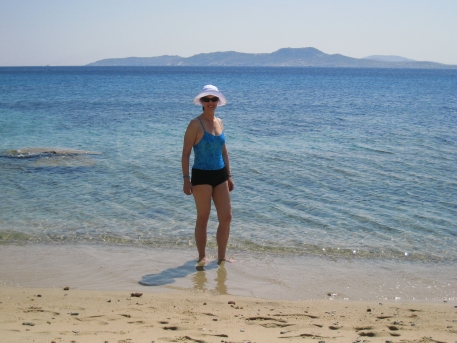
Jessica at the beach that she and Valerie visited to soak up some rays
(with Delos in the background)
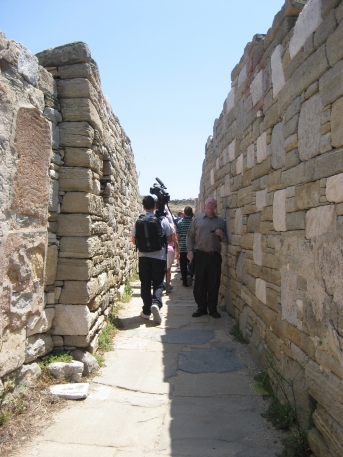
Reid among the ruins of Delos

Mark, Reid and Stewart with the Temple of Isis on the hills in the background
- Naples, Italy
We had arranged for another private tour here in Naples. The idea was that our guide/driver (one and the same here) would pick us up at the dock, take us down the Amalfi Coast, then on the way back we would visit Pompeii. Our guide, Franco, was waiting when we left the dock, and even managed to find us when we came out the wrong door (he spotted David's red hat, which we told him to look for). We bundled into the van and headed south. From Naples we passed on the west side of Mt Vesuvius, the volcano that wiped out Pompeii in 79AD. Our first stop was Sorrento, a picturesque city on the Gulf of Napoli, part of the Tyrrhenian Sea. We were able to do a little shopping here, bought some really delicious coconut gelato, and found a store that seemed to sell nothing than really overpriced chess sets, most of them completely unplayable.
From there we continued south and east to Positano, a truly spectacular city, seemingly carved into the cliffs above the Gulf of Salerno. The streets are mostly one-way here, and constantly narrowing. For a while, a bus could navigate the streets, but then it was only cars, then only motorcycles, then only pedestrians. We spent about an hour here wandering our way down (and we do mean down) to the beach. Once again there's a heavy dependency on tourism, and many of the shops offered clothing at prices that made your eyes bug out.
Finding our way back up to Franco, he told us that he had taken the liberty of making lunch reservations at a small restaurant. He said they didn't actually have a menu, that's how small they were. He drove us up, up, up along the cliff face, finally brining us to this quaint restaurant that seemed to be hanging onto the side of the cliff. Oddly enough, given the steepness of the hills, the narrow streets and the tiny homes sharply one above the other, we passed by - and had a partial view of from the restaurant - a large soccer field! Obviously their national sport took precedence over such minor considerations as the difficulty of carving a level soccer field out of the steep hillside. Our restaurant table had a wonderful view of the whole coast and the city of Positano. As we sat down, the two bottles of wine appeared (one red, one white) and the food started coming. There must have been 10 plates of appetizers passed around among the seven of us, and when we thought we couldn't eat any more, the pasta dishes arrived. Spaghetti, ravioli, lasagna, etc, etc, etc. Then the limoncello drink arrived. This stuff is made from Sorrento lemon peel, and is at least 35% alcohol. It's more like lemon cough syrup, it has a real kick going down, and since the legal drinking age in Italy is 16, Mark tried his first alcohol by shooting the limoncello. I think it will be a while before his next drink. This was followed by plates of delicious desserts.
We all rolled out of there back into the van, where Franco drove us to the ruins of Pompeii, while several of us napped. We did the classic Rick Steves tour from our book and caught most of the highlights. Each of these ancient cities we visted (Ephesus, Delos, Pompeii) were very interesting in their own way. Franco was waiting for us when we finished and delivered us back to our ship in plenty of time. He was great!
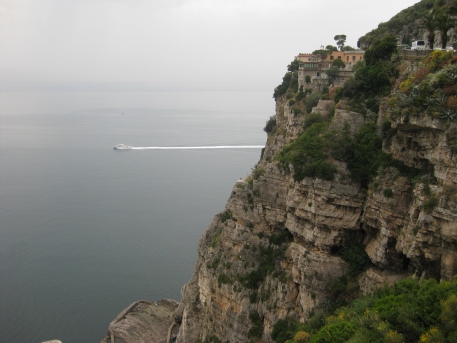
Down the Italian Amalfi Coast, near Sorrento
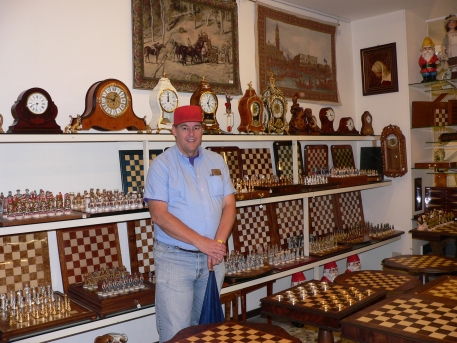
Lot's of chess sets, but David wouldn't play with them
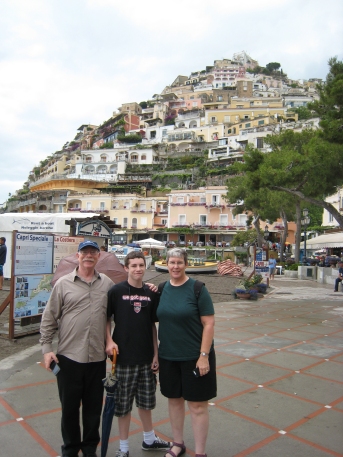
Reid, Mark and Meg on the beach in Positano

Jessica takes a picture from the window of our restaurant above Positano

Meg, Jessica, Mark, Reid and Valerie in Pompeii
This was our biggest day. The ship put into the port of Civitavecchia, which is about 40 miles from the center of Rome. We had arranged for our last private tour with our guide "Sal". We easily caught the train in Civitaveccia and arrived in Rome at St Peter (San Pietro) station around 8:30a. Sal was right there when we got off and walked us to the Vatican. We walked through St Peter's Square to get to the Vatican Museum entrance. We came upon the back of the line, which seemed not that large, until we turned the corner and saw that it extended the entire block about six people wide. Sal had us blast right on by and marched us up to the special entrance used by official tour guides. In mere moments we had our tickets and were inside. Many of us expressed the feeling that we had already gotten our money's worth out of this tour. We went up some escalators and Sal pointed out some of the more important pieces of sculpture and artwork. If you have been there, you know it is simply overwhelming. You could spend a month in this museum and still not see everything. We saw the Gallery of Maps and a room with frescoes on the ceiling that you would swear are 3D sculptures, but on very close examination are just paintings. We slowly wound our way towards the Sistine Chapel, perhaps the most famous building in the Vatican. Sal must have spent 45 minutes with us in the Sistine Chapel, detailing the history of the building, how and when the paintings were done and, of course, a lot about Michaelangelo. To our chagrin, no photography is allowed in the chapel. On exit we found ourselves back in St Peter's Square, very close to the entrance to St Peter's Basilica. Sal seemed to know the quickest part of the line to use and we were inside in just a minute or two. What the Vatican Museum does in numbers, the basilica does in size. It's difficult to express just how huge this place is. For instance, looking up near the ceiling, there are some mosaics. In one of them, and man holds a feather, used as a quill pen. You can make it out easily. Sal told us the pen was eight feet long. Who can make an eight foot pen out of tiny mosaic tiles? The famous Pietà is here, along with a zillion other impressive statues, sculptures and mosaics. It's breathtaking.
On our way to the van, we passed by a couple members of the Swiss Guard (who wear uniforms that would only be found in a circus in the US). Our driver then met us and we piled into the van. Our next stop was the Pantheon. This was built in 126AD as a temple to all the gods of ancient Rome. To this day it still has the largest unreinforced concrete dome anywhere. Like many building of its age, it was conscripted and used as a Roman Catholic church (which it still is), but nowadays also serves as a tourist attraction. Light is provided by a hole in the top of the dome (and acts like a sundial), and there is special drainage built into the marble floor for when it rains. While there we bought sandwiches from a nearby shop and had a quick bite at the base of the obelisk that adorns the square. Surrounding us were supposedly the most expensive apartments in all of Rome.
Back to our van, our next stop was the Colosseum. The Colosseum in Rome is a true amphitheater, that is two theaters facing each other with the stage in the center. All of the other theaters we encountered were half circles. This place has been really picked over by early people looking for marble and metal (this was used in the huge staples that held the blocks of stone together), but it's still impressive today. It doesn't take much imagination to see how it would have appeared in its heyday. From the Colosseum we had a good view of the Temple of Venus and Roma, which are right across the road.
Next our driver took us along the Appian Way on a road that felt as if it had been constructed in the 4th century BC. We saw one of the famous milestones shortly after leaving the city through Porta San Sebastiano. This took us to one of the many catacombs that surround Rome. Except for the signs telling you where the catacombs are located, you would have no idea that a multi-level underground labyrinth had been carved out of the earth. We descended several flights of stairs and found ourselves in the cool, moist air of these burial vaults. We spent about a half hour visiting a very small section of the system (you could see by the maps they had how easy it would be to get lost down there). The loculi (burial spots) are carved into the walls every few feet. They seem to be sized just large enough to hold the occupant (some very small ones held a child or infant).
Soon it was back into the van and back into the city. Our next stop was the Circus Maximus where the famous chariot races took place in ancient times. As time was running short, we only spent a few minutes here, as we were on our way to Trevi Fountain. We had to park a block away, and then we had to fight the crowds to get close enough to toss in a coin. We left a euro or two behind in the water and met our driver again on the other side of the fountain. We were headed back to the train station at this point, but our driver made a point of driving by the famous Spanish Steps, which linked the Bourbon Spanish Embassy, and the Trinità dei Monti church in 1725. After this it was on to St Peter's station where we caught the next train north (had to wait about 10 minutes) and an easy walk from the Civitaveccia station to our shuttle. As we were in a hurry, we took the shuttle to the Carnival Magic, which was docked right behind the Ruby Princess. It was still a quarter mile trek from there to our ship. One more stop in Italy...

Jessica in one of the many halls of the Vatican Museum
It's mind-boggling how much sculpture and artwork is here
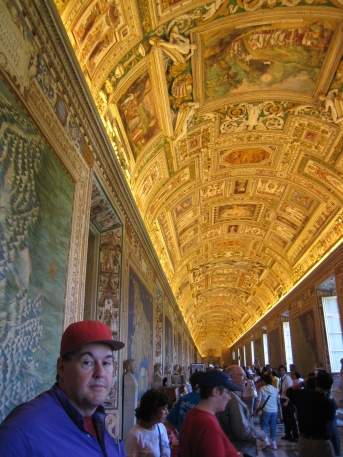
David, Valerie, Meg and Reid in the
Gallery of Maps inside the Vatican Museum

Meg, Jessica, Sal (our guide), Valerie and David inside St Peter's Basilica
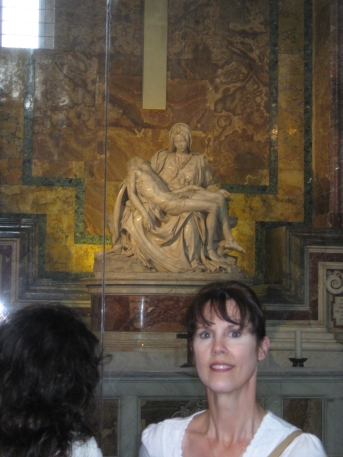
Jessica with the Pietà in St Peter's Basilica
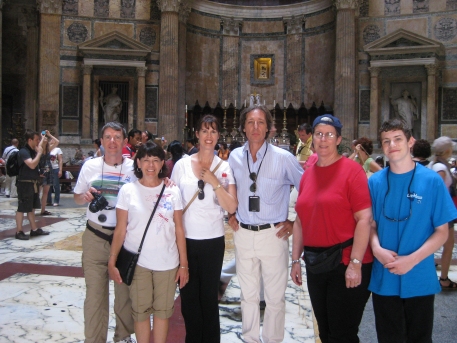
Stewart, Valeria, Jessica, Sal, Meg and Mark inside the Pantheon
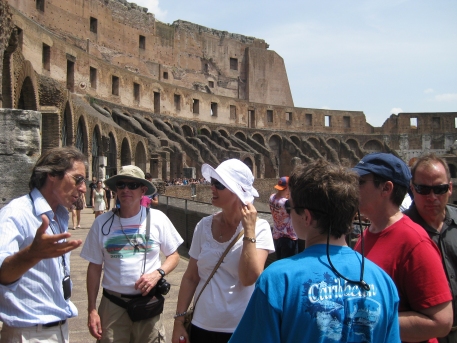
Sal explains to Stewart, Jessica, Mark and Meg inside the Colosseum
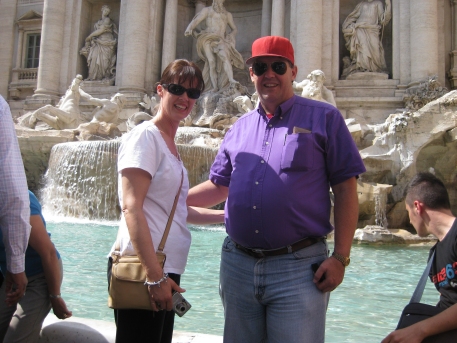
Jessia and David at Trevi Fountain
Today was an adventure. We did not book a private tour, or a tour through the ship for Florence and Pisa. Meg, Reid and Mark had been to both Florence and Pisa several times in the past and they elected to visit the port city of Livorno. So it was David, Jessica, Stewart and Valerie who opted to take the train to central Italy to visit these two famous cities. Perhaps our biggest complaint of our entire cruise was with the city of Livorno. The port itself is very large, and they naturally don't want people wandering around it unescorted. To get to the train station of Livorno you might think you should take a taxi or a shuttle, but taxis in this city, and the standard shuttle are prevented by law from taking you to the train station? "Why", you ask? Our best guess is they want to extort money from you by forcing you to take the "special shuttle" or a city bus. The special shuttle runs once in the morning (at 8:30a) and once in the evening (at 5:00p) to and from the ship and train station. The cost of the shuttle is €12.00, the cost of a train ticket from Livorno to both Florence and Pisa is €13.00. Not only that, you are robbed of three hours of time because the ship gets in at 7:00a (but you can't leave until 8:30a) and you must be back on board by 7:00p (but the shuttle gets you back around 5:30p). That's three hours you can't spend visiting the Leaning Tower or the Uffizi or the Academia or a bunch of other things you would like very much to visit. I'm not done complaining. Our party of four takes the special shuttle to the Livorno train station and we arrive at 8:50a. The train we want leaves at 9:10a. There are three ticket windows open, but for the entire time we were in line, one of the windows was occupied by a couple who were not trying to make the 9:10a train, they had some other issue, but were in no hurry. On top of that, the two people working the other two windows had at least 25% tree sloth in their ancestry. I'm not exaggerating. As we watched the minutes tick by, finally, one of the windows cleared at 9:09a. David and Stewart ran up and asked for four tickets to Florence. It was painful to see just how slowly this man could move. He had absolutely no concern for the increasing frustration of those still in line, or even those at his window. As he slowly printed our tickets and even more slowly made our change, we grabbed everything and ran down the hall towards the platforms. Tickets of this nature must be validated in order to be used, so we had to stop for a moment and push the tickets into the yellow validation box, then down the stairs and towards the platform. When we emerged above ground, our train was there and we all jumped into whatever open doors we could find. There was scattered seating so Jessica and Val were at one end of the car, and David and Stewart were across the aisle from either other at the other end of the car. As David sat down, a girl (which he found out was from Ecuador) asked him what time the train left? David looked at his watch and said, "Four minutes ago." We only made this train because it was running about five minutes late. People who missed this train had to wait for the 10:10a train, and it was delayed by two hours as someone fell onto the track between Pisa and Florence.
With all that behind us, the trip to Florence was uneventful, and we found our way out of the station and headed to the Cathedral of Saint Maria. Once there we headed south towards the Uffizi Gallery, where we had reservations for 11:30a (Jessica made these reservations well in advance, and it's good that she did, as we were able to bypass some long lines). Inside the Uffizi Gallery we saw a lot of sculpture and paintings from the Renaissance, but works by Michaelangelo were not in abundance. It's still not clear to us if those sections were closed, or if they were somewhere we went past, but the only piece we saw for sure was a copy of David that stands outside in the square. If you want to see the original you have to go to the Accademia Gallery, which is further away. From a window in the Uffizi we had an excellent view of the famous Ponte Vecchio bridge, that royalty used to use in order to cross the Arno River without being seen. Leaving the Uffizi we spent some time in the Piazza della Signoria, admiring some of the artwork on display, including the Fountain of Neptune, and Perseus with the Head of Medusa by Cellini. We then went back to the cathedral and waited in line to climb the 550 steps to the top of the dome until we realized which line we were in, then switched to the line to enter the cathedral, which moved much faster. This cathedral is really huge, and at 502 feet in length, rivals St Peter's Basilica in Vatican City. There was a train that left Florence at 2:30p, getting into Pisa at 3:30p and that would allow us an hour to see the Leaning Tower and get back for the 4:30p train to make Livorno by 4:50p. We decided to go for it and arrived in Pisa at 3:28p, noting that the next train left Pisa at 4:32p, giving us one hour and four minutes to do it all.
It didn't take long to realize that there were no cabs to be found. We asked around and were told where the bus stop was, and that we needed to wait for the "red" bus. By about 3:45p we saw the bus coming and bought our tickets from the driver for €1.50. The bus careened around town, down this way and that, over the river, stopping here and there for the locals. Finally it pulled up at the Field of Miracles, and I must say the view of the Baptistry, the Duomo Cathedral and the Leaning Tower is breathtaking. If it wasn't for the endless tacky souvenir shops this place would have been awe inspiring. But! We were under the gun! By now it's after 4:00p, and we don't know when the returning bus comes along. Half of our time has been used up getting here. We walk down the Field of Miracles, trying to avoid being hit by tourists pretending to hold up the tower for a photograph and take a minute to take our own photos (I'm happy to say that no one in our party pretended to shore up the tower). Now it's about 4:07p and we turn around and head to the bus stop. Once again we are told to wait for the "red" bus, but as the minutes tick away, no buses at all are arriving. Finally, at around 4:15p, the "orange" bus arrives and the large crowd of people that had been waiting all jump on board. Jessica asks the driver if this is the bus to the train station, but he just makes a motion with his hand rather than a reply. She asks a second time, more sign language. A third time gets the same result. We decide to jump on and the doors smack Stewart in the backpack. Now Valerie attempts to find out where we are going, but gets no better answer. We do seem to be going in the right direction, but as we approach the Arno, the bus turns left and parallels the river. We come to a light and David says, "If we don't turn right here, we are in big trouble." The light turns green and... we turn right. Then we turn right again, still going along the river. But then a left. This seems to be the right way. Along with all the other people on the bus is an Asian family, father, mother and two kids about five and six. At one stop the mother and kids get off, but it's the wrong stop! Before they can get back aboard the doors close and the bus roars away with the father! But in just a moment we see the train station ahead! By now it's 4:24p. The driver pulls to a stop in front of the station and... the doors don't open, instead the bus starts to move again. It seems that everyone on this bus is trying to make the 4:32p train and the shouts of "Stop" ring out from everywhere. However, it turns out the driver was just trying to position the bus properly at the stop, and we only moved about one bus length. The doors open and people cascade off the bus like a dam break. By now it's 4:25p and we follow suit, but at a brisk walk instead of the more popular sprint. We get to the platform at 4:28p and the train has yet to arrive. One of the more pleasant sights as we waited for the train was the Asian mother with her two kids; the stop had been close enough to the station that she had caught up with her husband and they all made the train as well. The ride to Livorno was about 20 minutes and our shuttle was waiting to take us back to the Ruby Princess.
After we were aboard we spoke with Meg, Reid and Mark about their day in Livorno. It was all uneventful until they decided to go back to the ship. The shuttle they used left from the center of town and would take you back to your specific ship (they needed to take the shuttle back to the Ruby Princess), but that shuttle was unavailable, so they decided to once again take a shuttle to a ship that was nearby. Leaving that shuttle, they started to walk to the Ruby Princess when they encountered a tall wire fence that completely enclosed them in with the ship they had ridden to. This fence extended over the side of the pier, leaving about a 10 foot drop into the water. As they considered their predicament (getting back on a shuttle to the center of town, the getting back on the proper shuttle to the Ruby Princess), a ship's officer came along and swung himself out over the water and back onto the pier in one swift motion. Well, if he could do it, they could do it and one by one they grabbed onto the pole that held the fence out over the water and swung themselves over onto the side with the Ruby Princess. We were told that Reid did this one-handed, holding his iPhone in the other hand.
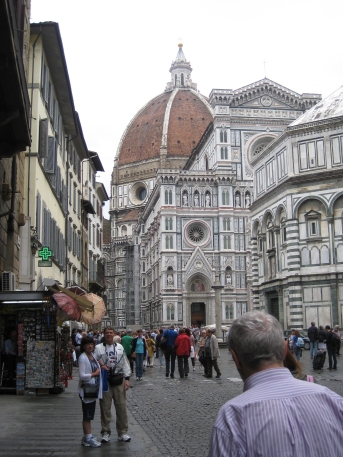
Valeria and Stewart as we approach the Cathedral of Saint Maria
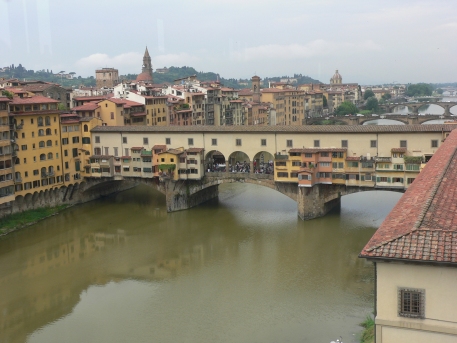
The Ponte Vecchio Bridge over the Arno from the Uffizi Gallery

David with David in Florence

Stewart and David with the Leaning Tower of Pisa

Mark looks back after being first to swing around the fence
- Monte Carlo, Monaco
In Monte Carlo, David and Jessica signed up for a tour of the St Nicholas Cathedral and the Prince's Palace, while Meg, Reid and Mark visited the local aquarium, and Stewart and Valerie wandered around and tried to trace the route of the Formula One race that had taken place a few weeks earlier. Our tour included the church were Prince Ranier and Princess Grace were married and buried, along with the Royal Palace and a lot of time to wander down the small streets looking at all the tchotchkes on sale. The palace tour was self guided and very informative. The ship left Monte Carlo early and we were back on board in plenty of time for lunch (we were unable to visit the famous casino, as it didn't open until 2:00p, and our ship left port at 1:30p).
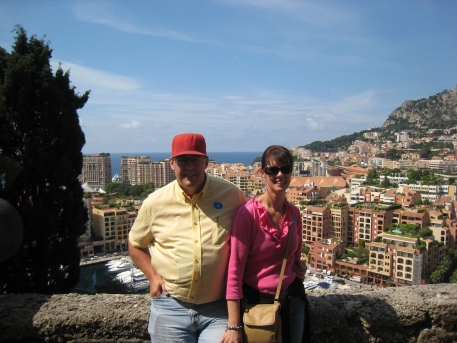
David and Jessica with the view of Monte Carlo from the Palace
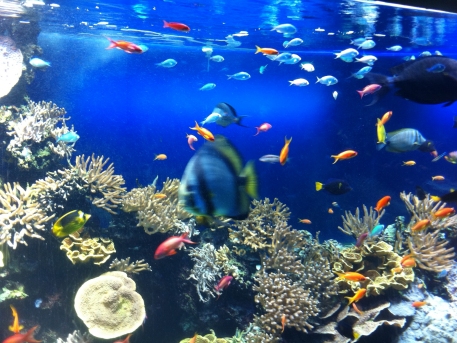
Meg, Reid and Mark went to the aquarium
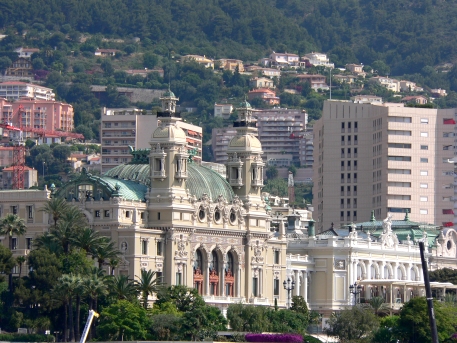
The famous Monte Carlo Casino
(that didn't open until after we had to leave)
- Barcelona, Spain
One of the most difficult things to do in life is leave a cruise ship, and this time was no different. After 12 days of being fed, entertained and pampered, it was time to go back to reality. We ate our final breakfast in the main dining room and made our way off the ship. Meg, Reid and Mark left on their own and caught a cab to the hotel at which we were spending the night. David, Jessica, Stewart and Valerie disembarked together and found the cab stand easily. The cabby drove us to our hotel where we were able to drop our luggage. We all went for a long walk through the city of Barcelona, mostly up La Rambla (The Avenue) which has a wide pedestrian walkway running up the middle, covered with shops and performers guaranteed to attract the tourists. It seemed every hundred yards another street performer in some outlandish costume to make them look like a statue (bronze, marble) was posing for photos.
We ended up walking all the way to the Sagrada Familia (Sacred Family) church. This place is still under construction, and is being completed according to the designer's (Antoni Gaudi) original design, even though he died in 1926. Even unfinished, the structure is awe inspiring. We opted not to go in, mostly because of the cost and the lines (I think this was the only church we encountered that wanted money to go inside).
We got a bite to eat at a Subway sandwich shop and then decided on our next course of action, which was not to include walking. We decided to take the underground and found that we could quickly get to a lot of interesting sights. We visited the local Arch of Triumph (not quite like the one in Paris), then took the subway back to our hotel. We retrieved our luggage and checked in, very nice rooms.
For dinner we decided to try some authentic local fare, and were told of a restaurant several blocks up the street. Once again we walked and found the place easily, but it didn't open for about an hour (people there tended to dine much later, especially since the sun didn't go down until around 9:00p). But the place next door was open and we took a table. We feasted on tapas and paella and sangria. A wonderful meal. We walked back to the hotel in two parties, Reid, Mark and Valerie in the lead, with David, Jessica, Stewart and Meg trailing. We said our good nights and farewells, as Stewart and Valerie had an early flight out to get back to San Francisco.
In the morning the remaining people had breakfast in the hotel serve yourself buffet, then packed up for the trip home. We decided to take the subway to the bus stop, then catch the "air bus" to the airport. This would have all worked much much better if a) the elevators at the subway stops were working (had to take the luggage down the stairs) and b) if it wasn't raining. Even though the air bus stopped outside the subway stop, it was on the other side of a very larger traffic circle. By the time we got on board it was like a sauna in that bus. The windows were all steamed up and we had to trust that the driver knew the roads without being able to see them. Barcelona Airport has one stop for the air bus. Everyone gets off together and walks a short distance to the terminal. There are multiple entrances to the terminal with airline names above each one. Just walk until you find yours and it's much easier then walking through the terminal looking for it. At the airport we said our goodbyes to Meg, Reid and Mark, who themselves were splitting up, with Reid and Mark headed to Israel and Meg back to Tucson.
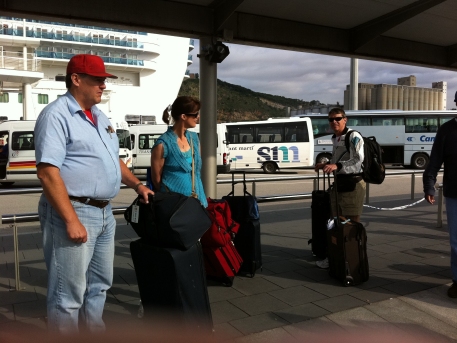
David, Jessica and Stewart having disembarked, waiting for a cab
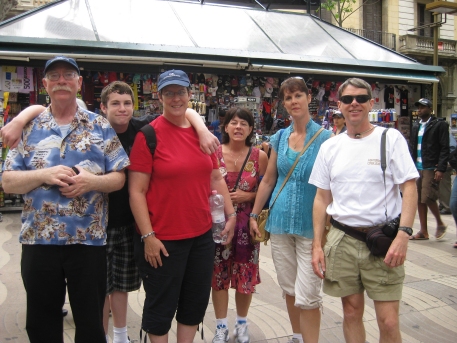
Reid, Mark, Meg, Valerie, Jessica and Stewart on La Rambla
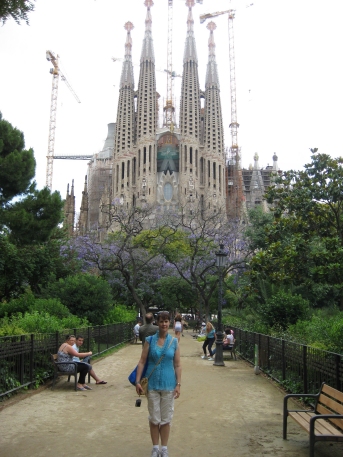
Jessica in front of Sagrada Familia in Barcelona

Mark, Meg and Reid at the Barcelona Arch of Triumph

Meg, David, Valerie, Jessica and Stewart wait for the sangria to arrive
- David & Jessica's trip home - Barcelona, Spain to Miami, Florida to Los Angeles, California
David and Jessica got boarding passes, checked the luggage and waited for the 1:30p flight to Miami, Florida. Our flight was a little late leaving (about 30 minutes), but we arrived in Miami in plenty of time to go through customs and immigration, then get our boarding passes for the flight to Los Angeles. David slept for much of the last leg of the journey, but Jessica's seat would not recline and she had a tough time. We arrived in LA at around 11:45p (on a day that was 33 hours long for us) and were outside with our luggage for only a few seconds when our son, Alex, pulled up to the curb. We threw the bags into the hatchback, jumped into the car and were home in Lake Forest inside of an hour. A long, but very fun and exciting trip spent with friends and relatives. Very few hiccoughs along the way. We all agreed we would be happy to cruise with Princess again.

Jessica leaves the SkyTrain in Miami International
- Meg, Reid and Mark's trip home
All flights home were uneventful. The cat was thrilled to see Meg, usually she doesn't care.
- Shipboard Experiences
- Trivia Games - we tried to play the trivia games whenever we could, and we won the first time. However, that was also the last time we won. The trivia was extremely hard, I can't believe some of these questions were actually answered correctly.
- Weakest Link - both David and Jessica were among the eight initial contestants. David was the fifth person eliminated, and Jessica ended up going head to head for all the marbles, but couldn't remember what compass point the good witch from The Wizard of Oz came from and came in second.
- Where In the World is Ryan - Assistant Cruise Director Ryan presented pictures from his travels and the teams had to name the monument/location and the city. Stewart kicked himself for not recognizing the Bay Bridge into Oakland from his home area. Valerie knew right away what it was but nobody believed her so we got it wrong in spite of her brilliance.
- Anytime Dining - We enjoyed the Anytime Dining, we only had to wait once for a table and we made reservations on the first formal night with no problem. The food was wonderful, some of us got extra appetizers and desserts. Stewart purchased a "soda card" on the first day and treated himself to an endless supply of Diet Cokes while on board.
- Entertainment - Every night we took in the professional entertainment in the ship's large theater. Due to exhaustion, jet lag, wine and so-so performances, it was a real challenge to stay awake. The Scottish violinist was very good, and the big stage magician was pretty good, but the comedian was just not funny. However, the last two nights made up for it all. The ship's crew put on a talent show that was great fun, and on the final night they put on a musical version of Alice in Wonderland with spectacular special effects and great costumes.
- Cooking Demo and Gallery Tour - The executive chef and the maitre d' put on a very nice cooking demo. They made an entire meal on the Princess Theater stage, including pasta, egg plant parmesan, cold soup and tiramisu. We then went on a tour of one of the galleys, which were huge and spotlessly clean.
- Game Room - David spent time in here with his chess set hoping to get games, while Jessica would play Bananagrams with anyone who was willing.
- Past Guest Reception - Reid and Meg were invited to the Past Guest Reception with the captain. There were so many past guests that they held two of these. There were free drinks and snacks. The captain spoke and then we could get our picture taken with the captain if desired. It was nice to do it this way instead of taking pictures with the captain on the way into the reception as some cruise lines do. Less congestion.
- Outdoor Movies - Movies Under the Stars were shown most nights, there were padded loungers with blankets and free popcorn. Candy and soda were for sale.
- Cabin - Meg, Reid and Mark had an outside cabin with an obstructed view. There was very little obstruction. Service in the cabin was great, cleaned twice a day and well stocked. David & Jessica had an inside cabin which seemed larger than any they have had in the past. Stewart & Valerie had the same cabin type as David & Jessica, but were three decks directly above the theater stage, and could hear the music being played if they tried to sleep during showtime.
- Days at Sea (formal nights) - Nice formal nights, we had two on this trip. Everyone looked very nice dressed up.
- Table Tennis - Mark and Reid took full advantage of the ping pong table on the ship. Mark even participated in one of the tournaments.
- Gymnasium - Jessica and Stewart took advantage of the gym on several occations. The gym is up on the 15th deck and glass enclosed, overlooking the ocean as you sweat the extra desserts off.
- Bar Wars - This was a competition between the sexes where they attempted to recreate drink recipies made by the ship's own bartenders, plus one creation of your own. With professional bar tender Jessica on the women's team, it really wasn't a contest.
- Afternoon Tea and Scones - Tea was very pleasant, relaxing and tasty. Jessica loved the scones and whipped cream and had to force herself to a limit of one per day. Held most afternoons.
- Back Stage Tour - The Princess Theater held a back stage tour showing the costumes, lighting and the stage area. Most interesting. They answered all of our questions about the shows and performers.

Just the guys; David, Stewart, Reid and Mark in the main dining room
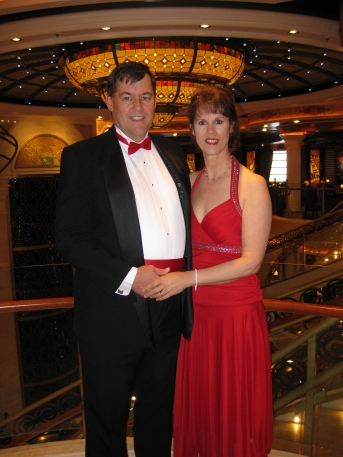
David and Jessica on the first Formal Night
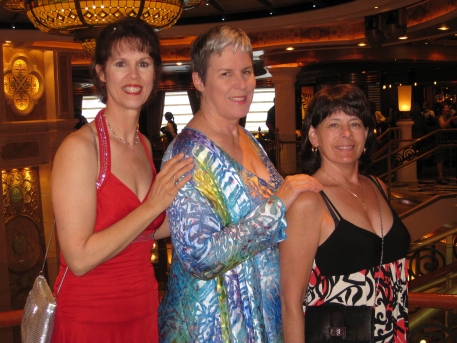
Just the gals; Jessica, Meg and Valerie on the first Formal Night
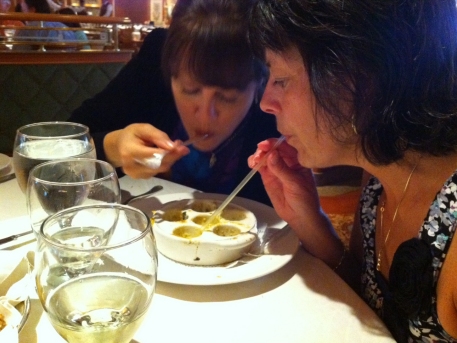
Jessica and Valerie share an appetizer of escargot
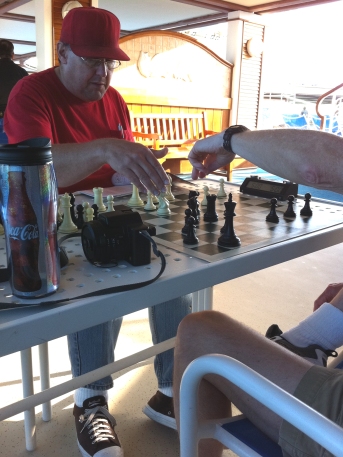
David and Stewart play chess out by the swimming pool